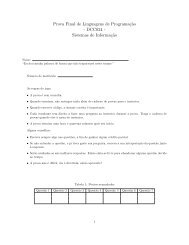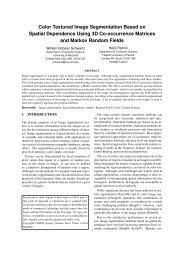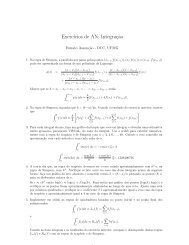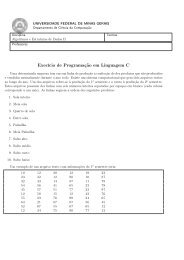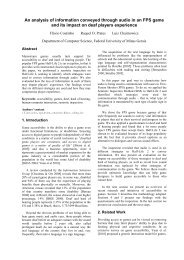Evolving Software Product Lines with Aspects: An Empirical ... - UFMG
Evolving Software Product Lines with Aspects: An Empirical ... - UFMG
Evolving Software Product Lines with Aspects: An Empirical ... - UFMG
You also want an ePaper? Increase the reach of your titles
YUMPU automatically turns print PDFs into web optimized ePapers that Google loves.
fewer components and operations. However, although the AO<br />
version concentrates the dependency in a few places (lower value<br />
of operation interlacing in Figure 8), this dependency is stronger<br />
than in the Java solution as highlighted by the higher value of<br />
LOC overlapping. In other words, feature boundaries are wider<br />
(more operation and component interlacing) in the Java<br />
implementation and deeper (more overlapping) in the AO solution<br />
of dependencies involving optional or alternative features.<br />
6.3 Scalability in Complex Dependencies<br />
The previous subsection discussed how the aspectisation of pairwise<br />
dependencies impacts different modularity attributes. This<br />
section discusses how conditional compilation and AOP scaled in<br />
dependencies involving a greater number of features. Figure 9<br />
describes some representative features organised in terms of<br />
releases and categories of dependency (Section 6.1). Each feature<br />
has different number of bars since they were introduced in<br />
different releases. The left-hand side of Figure 9 illustrates the<br />
inability of conditional compilation mechanisms to scale when<br />
complex dependencies among features occur. These charts<br />
support the analysis of impact on a set of features by introducing<br />
other new features. For instance, the introduction of two<br />
alternative features, MUSIC and VIDEO, in releases 7 and 8<br />
increased significantly the code overlapping among these features<br />
and also optional features, such as COPYMEDIA and SMS. This<br />
behaviour in some way was expected, since alternative features<br />
tend to reuse parts of existing code to implement their functionality.<br />
However, surprisingly the introduction of one optional<br />
feature also affected other optional features. This occurred, for<br />
instance, in the sixth release when the introduction of SMS<br />
increased code overlapping of this feature <strong>with</strong> COPYMEDIA. This<br />
higher overlapping represents in practice the existence of more<br />
explicit dependency between such optional features.<br />
We observed that the AO implementations usually scale well for<br />
all kinds of interlacing dependencies. AspectJ employs inter-type<br />
declarations to address component interlacing and pointcutadvices<br />
to deal <strong>with</strong> operation interlacing. The right-hand side of<br />
Figure 9 shows that no kind of interlacing is observed in all<br />
features analysed. However, the presence of overlapping can<br />
hinder a smooth dependency process and, sometimes, negatively<br />
affect the features being composed. This occurs because the<br />
60<br />
50<br />
40<br />
30<br />
20<br />
10<br />
Sorting<br />
0<br />
3 4 5 6 7 8<br />
Re le as es<br />
35<br />
30<br />
25<br />
20<br />
15<br />
10<br />
5<br />
0<br />
4 5 6 7 8<br />
Release s<br />
35<br />
30<br />
25<br />
20<br />
15<br />
10<br />
5<br />
0<br />
5 6 7 8<br />
Releases<br />
40 40<br />
35 35<br />
30<br />
25<br />
20<br />
15<br />
10<br />
5<br />
80<br />
70<br />
60<br />
50<br />
40<br />
30<br />
20<br />
10<br />
90<br />
80<br />
70<br />
60<br />
50<br />
40<br />
30<br />
20<br />
10<br />
0<br />
0<br />
0<br />
6 7 8<br />
7 8<br />
7 8<br />
Releases<br />
Releases Releases<br />
aspectisation of some specific scenarios <strong>with</strong> strong coupling<br />
between the features can violate modularity (Section 5.2). For<br />
example, the code described in Figure 2 was totally dedicated to<br />
the COPYMEDIA feature by the fifth release, but this code is<br />
moved to a new component (aspect) in release 7 because SMS<br />
and CAPTUREMEDIA depend on it. Again, AspectJ presents the<br />
same recurrent problem described above in which the introduction<br />
of one optional feature affects another optional feature. In<br />
addition, Figure 9 is useful to support the findings of Section 5<br />
which claimed that AspectJ succeeds in features <strong>with</strong> no shared<br />
code, i.e., no overlapping dependency.<br />
7. RELATED WORK AND STUDY<br />
CONSTRAINTS<br />
Recent research work has explored the use of AOP in the<br />
development or refactoring of SPLs [1, 3, 16]. Most of these<br />
investigations, however, only concentrate on the qualitative<br />
analysis of the features aspectisation process. For instance,<br />
Kästner et al. [16] presented a case study on refactoring the<br />
Berkeley DB system into a SPL. The authors reported several<br />
limitations on the modularisation of features when using AspectJ,<br />
such as the increase of coupling between aspects and classes due<br />
to the strong dependency of pointcuts on implementation details<br />
of the base code. In our work, we also found out some of the<br />
limitations reported by Kästner et al. [16]. In addition, we (i)<br />
categorised evolution scenarios in which AspectJ succeeds or not<br />
(Sections 4 and 5) and (ii) investigated the stability and scalability<br />
of this language to address feature dependencies (Section 6).<br />
There are also investigations on the development of SPLs<br />
focusing on the decomposition of architectures into features [3, 4,<br />
22]. Mezini and Ostermann [22] identified that feature-oriented<br />
approaches (FOAs) are only capable of modularising hierarchical<br />
features. They propose CaesarJ [21] that combines ideas from<br />
both AOP and FOAs to provide support to manage variability in<br />
SPLs. More recently, Apel and Batory [4] have proposed the<br />
Aspectual Mixin Layers [3] approach to allow the integration<br />
between aspects and refinements. These authors have also used<br />
size metrics to quantify the number of components and lines of<br />
code in a SPL implementation. Their study, however, did not<br />
consider a significant suite of software metrics and did not<br />
address SPL evolution and stability. Greenwood et al. [15] used<br />
Conditional Compilation<br />
Operation Interlace Operation Overlapping<br />
AOP<br />
Component Interlace Component Overlapping<br />
Favourites<br />
Copy Media SMS<br />
Photo<br />
Music<br />
Sorting Favourites Copy Media SMS<br />
3<br />
2<br />
1<br />
3<br />
2<br />
1<br />
0<br />
0<br />
3 4 5 6 7 8 4 5 6 7 8<br />
Releases<br />
Release s<br />
4<br />
3<br />
2<br />
1<br />
0<br />
5 6 7 8<br />
Re le as es<br />
Figure 9. Scalability of conditional compilation and AOP in complex dependencies<br />
4<br />
3<br />
2<br />
1<br />
0<br />
6 7 8<br />
Release s<br />
7<br />
6<br />
5<br />
4<br />
3<br />
2<br />
1<br />
Photo<br />
0<br />
7 8<br />
Releases<br />
Music<br />
10<br />
9<br />
8<br />
7<br />
6<br />
5<br />
4<br />
3<br />
2<br />
1<br />
0<br />
7 8<br />
Releases



